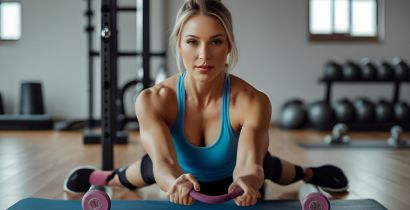Pilates is often mistakenly thought to be practiced only by people of certain body types. Social media has perpetuated the idea that Pilates is only for the very fit or that it is only available to females, leaving other body types feeling unwelcome. Over my 25 years of teaching Pilates and body rehabilitation and witnessing the transformations that Pilates can make, I can say that everyone can practice the forms of Pilates available today, and people of all body types can benefit from it.
Some of our clients say, “I didn’t think I was fit enough to do Pilates, until I found Fluidfor,” and “I was always intimidated to go to a studio before now.” Pilates was initially developed for the rehabilitation of soldiers and as a war rehab method. The use of Pilates has today extended to professional athletes, sporting teams, and as part of exercise routines for postnatal mothers. Its use as a rehabilitation method is one of the many reasons that Pilates is the fastest growing movement form. In India alone, the Pilates and yoga studio market was valued at $ 16.3 billion in 2024, projected to double in the next decade.
Eliminating the gender-related stigma surrounding Pilates
Changing the view of Pilates through addressing the holistic rehabilitation and body conditioning has meant incorporating Pilates into the training regime of rehabilitative practices and training professional male and female athletes within the framework of rehabilitation and training systems.
Everyone, irrespective of gender, has a multitude of muscular and structural compensations and weaknesses that reflect body composition and various lifestyle activities. Men, especially, have postural weaknesses and structural inflexibilities and tightness because of the repetitive and rigid training patterns of high-volume, intense resistance training.
Alleviation and dissipation of the compensatory blockage allows the body to move with confidence and without pain. No matter the fitness level, Pilates is an exercise, and it is functional in life. Pilates is great for those at the beginning of their fitness journey. Advanced movers and athletes are enabled with a greater level of focus. The stabilization and strength are built in a system of muscle toning and controlled fatigue.
The Evolution of Wellness Goals for Overall Health
The emotional toll of the coronavirus pandemic drew our attention to the need to prioritize and protect our health. A pandemic-induced focus on immunity shifted the primary reason for exercising to a more protective approach. Movement became a vital prescription for strengthening our bodies, improving our cardiac health, and uplifting our spirits.
Most people in the post-pandemic world want to feel better emotionally: the need to lose weight takes a back seat. Unlike body image, the psychological benefits of movement maintain a positive relationship with movement for a longer time.
People seek to minimize bodily aches and discomfort, maintain mobility, and improve flexibility. Many movement modalities and sports, such as running, strength training, football, tennis, and HIIT, benefit cardiovascular health and bone density.
Pilates Offsets Other Forms of Exercise
Weight training, running, and HIIT primarily target and build muscle, while Pilates focuses on the slow-twitch, stabilizing muscles. These muscles support the joints and regulate stabilization, balance, and postural control.
There will be a reduction in discomfort, and daily activities will become easier and less biomechanically imbalanced. You will become more flexible and efficient, and your overall movements will be more coordinated. There is an improvement in confidence and motivation with the ability to perform activities effectively and pain-free.
Learn More:- Magzilla Trends







